Papers by Joconiah Chirenda
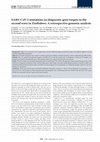
South African Medical Journal
Background. SARS-CoV-2 continues to be a major issue in resource-limited settings, particularly o... more Background. SARS-CoV-2 continues to be a major issue in resource-limited settings, particularly owing to the limited supply of vaccinescaused by inequitable distribution.Objective. To monitor diagnostic gene targets to identify potential test failures caused by mutations, which is important for public health.Methods. Here we analysed the genome sequence of SARS-CoV-2 from the second wave in Zimbabwe. A total of 377 samples weresequenced at Quadram Institute Bioscience. After quality control, 192 sequences passed and were analysed.Results. The Beta variant was dominant during this period, contributing 77.6% (149) of the genomes sequenced and having a total of 2994mutations in diagnostic polymerase chain reaction target genes. Many single nucleotide polymorphism mutations resulted in amino acidsubstitution that had the potential to impact viral fitness by increasing the rate of transmission or evading the immune response to previousinfection or vaccination.Conclusion. There were nine ...
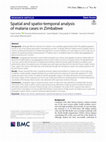
Infectious Diseases of Poverty, Oct 22, 2020
Background: Although effective treatment for malaria is now available, approximately half of the ... more Background: Although effective treatment for malaria is now available, approximately half of the global population remain at risk of the disease particularly in developing countries. To design effective malaria control strategies there is need to understand the pattern of malaria heterogeneity in an area. Therefore, the main objective of this study was to explore the spatial and spatio-temporal pattern of malaria cases in Zimbabwe based on malaria data aggregated at district level from 2011 to 2016. Methods: Geographical information system (GIS) and spatial scan statistic were applied on passive malaria data collected from health facilities and aggregated at district level to detect existence of spatial clusters. The global Moran's I test was used to infer the presence of spatial autocorrelation while the purely spatial retrospective analyses were performed to detect the spatial clusters of malaria cases with high rates based on the discrete Poisson model. Furthermore, space-time clusters with high rates were detected through the retrospective space-time analysis based on the discrete Poisson model. Results: Results showed that there is significant positive spatial autocorrelation in malaria cases in the study area. In addition, malaria exhibits spatial heterogeneity as evidenced by the existence of statistically significant (P < 0.05) spatial and space-time clusters of malaria in specific geographic regions. The detected primary clusters persisted in the eastern region of the study area over the six year study period while the temporal pattern of malaria reflected the seasonality of the disease where clusters were detected within particular months of the year. Conclusions: Geographic regions characterised by clusters of high rates were identified as malaria high risk areas. The results of this study could be useful in prioritizing resource allocation in high-risk areas for malaria control and elimination particularly in resource limited settings such as Zimbabwe. The results of this study are also useful to guide further investigation into the possible determinants of persistence of high clusters of malaria cases in particular geographic regions which is useful in reducing malaria burden in such areas.
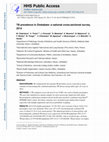
The International Journal of Tuberculosis and Lung Disease, 2022
BACKGROUND: We conducted the first national TB prevalence survey to provide accurate estimates of... more BACKGROUND: We conducted the first national TB prevalence survey to provide accurate estimates of bacteriologically confirmed pulmonary TB disease among adults aged ≥15 years in 2014.METHODS: A TB symptoms screen and chest X-ray (CXR) were used to identify presumptive TB cases who submitted two sputum samples for smear microscopy, liquid and solid culture. Bacteriological confirmation included acid-fast bacilli smear positivity confirmed using Xpert® MTB/RIF and/or culture. Prevalence estimates were calculated using random effects logistic regression with multiple imputations and inverse probability weighting.RESULTS: Of 43,478 eligible participants, 33,736 (78%) were screened; of these 5,820 (17%) presumptive cases were identified. There were 107 (1.9%) bacteriologically confirmed TB cases, of which 23 (21%) were smear-positive. The adjusted prevalences of smear-positive and bacteriologically confirmed TB disease were respectively 82/100,000 population (95% CI 47–118/100,000) and 3...
Pan African Medical Journal
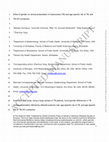
Open Forum Infectious Diseases
Background Previous studies have shown gender differences in tuberculosis (TB) incidence; however... more Background Previous studies have shown gender differences in tuberculosis (TB) incidence; however, gender disparity has not been well documented across granular categorizations of anatomic sites affected by TB and in the presence of human immunodeficiency virus (HIV) coinfection, largely due to small sample size for less common TB clinical presentations and lack of detailed clinical data. Methods The study population included TB cases aged ≥15 years (n = 41, 266) diagnosed in Harare, Zimbabwe. This cross-sectional study estimated male-to-female ratio (M/F ratio) for (1) age-specific TB incidence, (2) age-specific HIV prevalence among incident TB cases, and (3) 9 types of TB defined by affected anatomic site. Results Males were at a 53% higher risk of TB compared to females (risk ratio [RR] = 1.53; 95% confidence interval [CI], 1.12–2.09). Based on adjusted odds ratios (aORs) from multinomial logistic regression model, the odds of abdominal TB (aOR = 0.51; 95% CI, .39–.68), TB bones/...
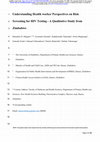
BackgroundThe use of screening tools during targeted human immunodeficiency virus (HIV) testing s... more BackgroundThe use of screening tools during targeted human immunodeficiency virus (HIV) testing services improves efficiency by identifying individuals who are likely to test positive. Effective utilization of screening tools requires an understanding of health care worker perception and willingness to use the tools. We determined health workers’ perspectives on screening tools to enhance their effective and consistent utilisation.MethodsWe conducted a qualitative study among healthcare workers at 8 selected primary healthcare facilities in Zimbabwe. Interviewer guided, in-depth interviews were conducted with healthcare workers and their immediate supervisors. Inductive and deductive coding (hybrid) was applied to develop and analyze themes following a framework built around the grounded theory model to describe perspectives that influence the effective and consistent utilization of HIV screening tools and suggestions for improved eligibility screening.ResultsBehavioural factors fac...

INTERNATIONAL JOURNAL OF SCIENTIFIC RESEARCH
Background: Zimbabwe has been implementing Index contact tracing and testing (ICT) since 2019 to ... more Background: Zimbabwe has been implementing Index contact tracing and testing (ICT) since 2019 to expedite epidemic control and accelerate the identication of people living with HIV. We identied two comparable provinces (structure, catchment, and location) yet with contrasting HIV prevalence rates to evaluate the program and develop recommendations that can enhance program performance. A process Methodology: evaluation of the ICT program was conducted in 8 randomly selected districts shared between Manicaland and Matabeleland South provinces. A logical framework model was applied to evaluate program inputs and processes, correlated with outputs and contributions toward outcomes. Microsoft Excel 2021 was used to summarize data as frequencies and proportions. W Results: e recruited 1,393 health workers over one year shared between Manicaland, 57.1% (n=795) and Matabeleland South 42.9% (n=598). An overall 80.6% (n=14,500) of the targeted Rapid test kits and 84.9% (n=24,200) of HIVST k...

Background: Zimbabwe has been implementing Index contact tracing and testing (ICT) since 2019 to ... more Background: Zimbabwe has been implementing Index contact tracing and testing (ICT) since 2019 to expedite epidemic control and accelerate the identification of people living with HIV. We identified two comparable provinces (structure, catchment, and location) yet with contrasting HIV prevalence rates to evaluate the program and develop recommendations that can enhance program performance.
Methodology: A process evaluation of the ICT program was conducted in 8 randomly selected districts shared between Manicaland and Matabeleland South provinces. A logical framework model was applied to evaluate program inputs and processes, correlated with outputs and contributions toward outcomes. Microsoft Excel 2021 was used to summarize data as frequencies and proportions.
Results: We recruited 1,393 health workers over one year shared between Manicaland, 57.1% (n=795) and Matabeleland South 42.9% (n=598). An overall 80.6% (n=14,500) of the targeted Rapid test kits and 84.9% (n=24,200) of HIVST kits were supplied, resulting in intermittent shortages in both provinces. A copy of the ICT register was supplied per facility against an average of 3 entry points each. Manicaland conducted 33.5% of their targeted ICT trainings against 80% for Matabeleland. Program implementation was scored at 62.2% for Manicaland and 81.8% for Matabeleland South. Manicaland scored an HIVST reactivity rate of 7.7% (871/11,320) whilst Matabeleland South documented a reactivity rate of 6.2% (679/10,890) against a target of 10%. Both provinces scored above 60% of their target for the identification of HIV-positive individuals (Manicaland: 61.1%, Matabeleland South: 79.5%). An overall positivity yield of 62.8% (n=742/1,181) was obtained among index contacts.
Conclusion: Index testing proved to be a resource-intensive HIV testing model yet highly effective in identifying individuals living with HIV among index contacts. The resource demand is justified by the high positivity yield which can be aided by implementation fidelity, critical to expediting epidemic control by mopping up clients living with HIV without the knowledge thereof.
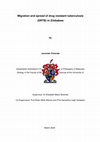
Thesis (PhD)--Stellenbosch University, 2020.ENGLISH ABSTRACT: The Southern African Development Co... more Thesis (PhD)--Stellenbosch University, 2020.ENGLISH ABSTRACT: The Southern African Development Community (SADC) is characterised by extreme poverty, malnutrition, high human immunodeficiency virus (HIV) prevalence in the adult population and weak health systems. These factors promote transmission of tuberculosis (TB), rifampicin resistant and multidrug resistant (RR/MDR)-TB. Countries with high TB incidence in the SADC region were, South Africa (768/100,000), Namibia (729/100,000), Botswana (360/100,000), Lesotho (411/100,000) and Swaziland 854/100,000 population. Zimbabwe, with an estimated TB incidence of 221/100,000 shares poorly controlled borders with two of her highly burdened neighbours, South Africa and Mozambique. Although the World Health Organization (WHO) estimated RR/MDR-TB prevalence for Zimbabwe was 1,500 per year, the country reported 406 cases in 2018. The drug resistance survey (DRS) estimated that the RR-TB prevalence was 4% among new patients and 14.2% among retr...
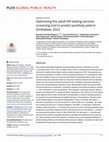
PLOS Global Public Health
HIV positivity yield declined against increasing testing volumes in Zimbabwe, from 20% (1.65 mill... more HIV positivity yield declined against increasing testing volumes in Zimbabwe, from 20% (1.65 million tests) in 2011 to 6% (3 million tests) in 2018. A screening tool was introduced to aid testers to identify clients likely to obtain a positive diagnosis of HIV. Consequently, testing volumes declined to 2.3 million in 2019 but positivity declined to 5% prompting the evaluation and validation of the tool to improve its precision in predicting positivity yield. A cross-sectional study was conducted. Sixty-four sites were randomly selected where all reporting clients (18+ years) were screened and tested for HIV. Participant responses and test outcomes were documented and uploaded to excel. Multivariable analysis was used to determine the performance of individual, combination questions and screening criteria to achieve >/ = 90% sensitivity for a new screening tool. We evaluated 13 questions among 7,825 participants and obtained 95.7% overall sensitivity, ranging from 3.9% [(95%CI:2.5...
Diabetes Research and Clinical Practice
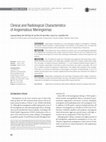
Academic Journal of Second Military Medical University, 2008
Background Angiomatous meningioma is a rare histological subtype of meningioma. Therefore, this s... more Background Angiomatous meningioma is a rare histological subtype of meningioma. Therefore, this specific medical condition is rarely reviewed in the literature. In the present work, we report the clinical and radiological features with postoperative outcomes of angiomatous meningioma. Methods This retrospective study included the patients who were pathologically diagnosed with angiomatous meningioma after surgical resection between February 2010 and September 2015 in our institute. We analyzed the clinical data, radiological manifestation, treatment and prognosis of all patients. Results The 15 patients (5 males and 10 females) were diagnosed with angiomatous meningioma during the study period. The median age of patients at the time of surgery was 63 years (range: 40 to 80 years). According to Simpson classification, 7, 5, and 3 patients achieved Simpson grade I, II, and IV resection, respectively. In the follow-up period, recurrence was noted in one patient. Ten out of the 15 patients showed homogeneous enhancement. Two patients demonstrated cystic changes. There was no occurrence of calcification or hemorrhage in our patients. Characteristically, 14 out of 15 patients showed signal voids of vessels. Significant peritumoral edema was observed in the majority of tumors (67%). Conclusion Angiomatous meningiomas are rare benign meningioma. Brain images of angiomatous meningioma usually demonstrate signal void signs and peritumoral edema. In the present study, angiomatous meningiomas showed good prognosis after surgical resection.
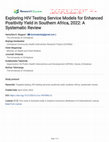
Background: In 2015, the World Health Organization issued HIV testing guidelines that shifted the... more Background: In 2015, the World Health Organization issued HIV testing guidelines that shifted the global focus on HIV testing, from testing for coverage to targeted testing. This was done to enhance positivity yield and increase efficiency in the utilization of finite resources. In response, various nations developed varied models of implementation, which has exposed varied implementation of the targeted testing mantra. Because of the varied interpretations as shown by the many models that were developed in response to the guidelines, the success of the strategies remains unknown. Targeted testing is particularly important for Southern Africa, which, until this day, bears a disproportionate burden of HIV. Methods: We, therefore, intend to conduct a systematic review of all studies on targeted testing models that were developed and are being implemented in Southern Africa. Further, we will examine each identified model and its documented contribution to the identification of HIV posi...
Central African Journal of Medicine, 2000
Central African Journal of Medicine, 2011
Central African Journal of Medicine, 2001
The International Journal of Tuberculosis and Lung Disease, 2014
Journal of Tropical Pediatrics, 2013
The International Journal of Tuberculosis and Lung Disease, 2012









Uploads
Papers by Joconiah Chirenda
Methodology: A process evaluation of the ICT program was conducted in 8 randomly selected districts shared between Manicaland and Matabeleland South provinces. A logical framework model was applied to evaluate program inputs and processes, correlated with outputs and contributions toward outcomes. Microsoft Excel 2021 was used to summarize data as frequencies and proportions.
Results: We recruited 1,393 health workers over one year shared between Manicaland, 57.1% (n=795) and Matabeleland South 42.9% (n=598). An overall 80.6% (n=14,500) of the targeted Rapid test kits and 84.9% (n=24,200) of HIVST kits were supplied, resulting in intermittent shortages in both provinces. A copy of the ICT register was supplied per facility against an average of 3 entry points each. Manicaland conducted 33.5% of their targeted ICT trainings against 80% for Matabeleland. Program implementation was scored at 62.2% for Manicaland and 81.8% for Matabeleland South. Manicaland scored an HIVST reactivity rate of 7.7% (871/11,320) whilst Matabeleland South documented a reactivity rate of 6.2% (679/10,890) against a target of 10%. Both provinces scored above 60% of their target for the identification of HIV-positive individuals (Manicaland: 61.1%, Matabeleland South: 79.5%). An overall positivity yield of 62.8% (n=742/1,181) was obtained among index contacts.
Conclusion: Index testing proved to be a resource-intensive HIV testing model yet highly effective in identifying individuals living with HIV among index contacts. The resource demand is justified by the high positivity yield which can be aided by implementation fidelity, critical to expediting epidemic control by mopping up clients living with HIV without the knowledge thereof.
Methodology: A process evaluation of the ICT program was conducted in 8 randomly selected districts shared between Manicaland and Matabeleland South provinces. A logical framework model was applied to evaluate program inputs and processes, correlated with outputs and contributions toward outcomes. Microsoft Excel 2021 was used to summarize data as frequencies and proportions.
Results: We recruited 1,393 health workers over one year shared between Manicaland, 57.1% (n=795) and Matabeleland South 42.9% (n=598). An overall 80.6% (n=14,500) of the targeted Rapid test kits and 84.9% (n=24,200) of HIVST kits were supplied, resulting in intermittent shortages in both provinces. A copy of the ICT register was supplied per facility against an average of 3 entry points each. Manicaland conducted 33.5% of their targeted ICT trainings against 80% for Matabeleland. Program implementation was scored at 62.2% for Manicaland and 81.8% for Matabeleland South. Manicaland scored an HIVST reactivity rate of 7.7% (871/11,320) whilst Matabeleland South documented a reactivity rate of 6.2% (679/10,890) against a target of 10%. Both provinces scored above 60% of their target for the identification of HIV-positive individuals (Manicaland: 61.1%, Matabeleland South: 79.5%). An overall positivity yield of 62.8% (n=742/1,181) was obtained among index contacts.
Conclusion: Index testing proved to be a resource-intensive HIV testing model yet highly effective in identifying individuals living with HIV among index contacts. The resource demand is justified by the high positivity yield which can be aided by implementation fidelity, critical to expediting epidemic control by mopping up clients living with HIV without the knowledge thereof.